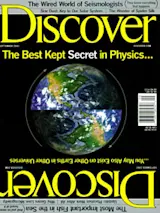It's a small world, people say, but they have no idea how small until they've been in Terry Wallace's office. On a recent morning, the prickly pear is budding in Tucson, the ocotillo is in full bloom, and Wallace is eavesdropping on a seismic disturbance 8,000 miles away. His computers at the University of Arizona simultaneously monitor 500 seismic stations around the world over the Internet, and they can link to hundreds more if there is a special reason to— as there is this morning.
The world's most advanced seismometer, a Streckiesen STS1, uses electronic feedback to measure vibrations of as small as a few micrometers and as brief as a millihertz. A bell jar isolates the mechanism from atmospheric pressure changes.
A report has appeared in The Washington Times that the Chinese may test a small nuclear bomb at Lop Nur, in western China. So Wallace has connected the ...



